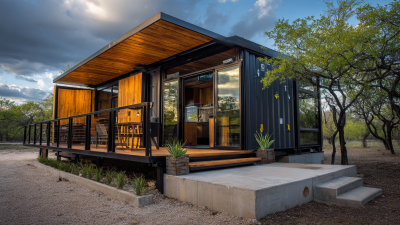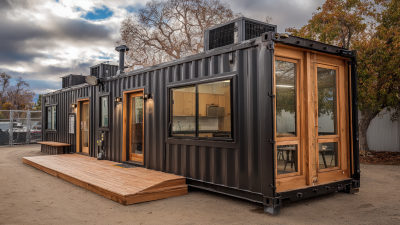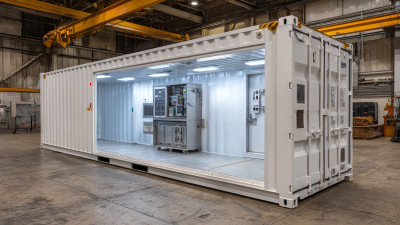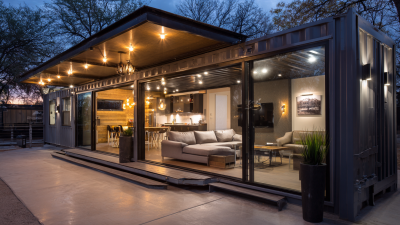Exploring the Rise of Shipping Container Houses: A Sustainable Solution for Affordable Housing
The rising popularity of shipping container houses has emerged as a transformative solution in the affordable housing sector, combating the global housing crisis that has seen nearly 1.6 billion people living in inadequate conditions according to the United Nations. These innovative structures not only repurpose discarded containers—approximately 500,000 of which are abandoned in U.S. ports alone—but also offer an eco-friendly alternative to traditional construction methods. By utilizing recycled materials, shipping container houses significantly reduce the carbon footprint associated with building new homes, aligning with the global push towards sustainability. A report by the McKinsey Global Institute highlights that such modular construction can lower costs by up to 20%, thereby making housing more accessible and economically viable for low-income families. As urban areas continue to grapple with skyrocketing real estate prices, the shipping container house is quickly gaining traction as a practical and sustainable solution to meet the urgent demand for affordable living spaces.

Understanding Shipping Container Houses as Affordable Housing Solutions
 Shipping container houses are emerging as a viable solution to the affordable housing crisis, offering an innovative approach that combines sustainability and cost-effectiveness. According to a report by the World Economic Forum, approximately 1.6 billion people worldwide lack adequate shelter, highlighting the urgent need for affordable housing solutions. Shipping containers, which are often available at a fraction of the cost of traditional building materials, can be repurposed into homes for as little as $10,000, depending on the design and location. This affordability attracts a growing number of architects and developers seeking to meet the needs of low-income families.
Shipping container houses are emerging as a viable solution to the affordable housing crisis, offering an innovative approach that combines sustainability and cost-effectiveness. According to a report by the World Economic Forum, approximately 1.6 billion people worldwide lack adequate shelter, highlighting the urgent need for affordable housing solutions. Shipping containers, which are often available at a fraction of the cost of traditional building materials, can be repurposed into homes for as little as $10,000, depending on the design and location. This affordability attracts a growing number of architects and developers seeking to meet the needs of low-income families.
In addition to their cost advantages, shipping container houses are praised for their environmental benefits. The construction of traditional homes generates significant waste and contributes to energy consumption. However, converting used shipping containers into homes is a sustainable practice that not only minimizes waste but also reduces the demand for new materials. A study from the American Institute of Architects (AIA) notes that using recycled materials for housing construction can decrease the carbon footprint by up to 35%. As more communities consider incorporating shipping container homes into their housing strategies, this trend could provide a practical response to urban housing shortages while promoting sustainable building practices.
Key Benefits of Shipping Container Homes for Sustainable Living
 Shipping container homes have emerged as a viable solution in the search for affordable and sustainable housing. One of the principal benefits of these structures is their environmentally friendly nature. Utilizing repurposed shipping containers significantly reduces construction waste and minimizes the demand for new materials. This transformation not only conserves resources but also addresses the growing concerns of urbanization and its impact on the environment.
Shipping container homes have emerged as a viable solution in the search for affordable and sustainable housing. One of the principal benefits of these structures is their environmentally friendly nature. Utilizing repurposed shipping containers significantly reduces construction waste and minimizes the demand for new materials. This transformation not only conserves resources but also addresses the growing concerns of urbanization and its impact on the environment.
In addition to their eco-friendliness, shipping container homes can be constructed with energy efficiency in mind. These homes can be outfitted with solar panels, energy-efficient appliances, and superior insulation to lower energy consumption. Furthermore, their modular design allows for flexibility in layout and size, making them suitable for various lifestyles and family needs. The affordability and versatility of shipping container homes coupled with their sustainable advantages position them as an attractive alternative in the housing market.
Step-by-Step Guide to Designing Your Own Container House
Shipping container houses are becoming an increasingly popular option for affordable and sustainable housing. The versatility of these structures allows for innovative designs, combining functionality with environmental consciousness. If you’re interested in creating your own container house, follow this step-by-step guide to bring your vision to life.
Start by sketching out your desired layout and floor plan. Consider factors such as the number of rooms, windows, and doors. It's essential to ensure that your design meets local building codes, so research regulations in your area thoroughly.
Choose the right size and condition of shipping containers. Make sure to inspect them for any damage and ensure they are suitable for housing. A common approach is to use one or multiple 20-foot or 40-foot containers based on your design requirements.
Create a stable foundation for your container house. This could be a concrete slab or piers, depending on your site and local building practices. Once the foundation is set, place your containers and secure them properly for stability.
Tips:
- Incorporate insulation and ventilation into your design to maintain a comfortable living environment.
- Use energy-efficient windows and doors to enhance insulation and reduce energy costs.
- Consider adding green features like solar panels or a rainwater harvesting system to maximize sustainability.
Essential Considerations When Building Container Homes
When considering the construction of shipping container homes, several essential factors must be taken into account to ensure a successful build that meets both aesthetic and functional needs. One of the primary considerations is the structural integrity of the containers themselves. While they are designed to withstand heavy loads, modifications such as cutting openings for windows and doors can compromise their strength. Therefore, it is crucial to engage with experienced architects or engineers who are knowledgeable about container modifications to maintain safety and durability.
Another vital aspect is insulation and climate control. Shipping containers are made of steel, which can lead to extreme temperature fluctuations inside. Implementing quality insulation systems is necessary to make the homes comfortable year-round. Furthermore, the choice of interior finishes and efficient ventilation systems can significantly enhance living conditions. Sustainability is also a key component; using eco-friendly materials and integrating renewable energy sources can minimize the environmental impact, making container homes not only affordable but also resilient and sustainable solutions for housing shortages.
Exploring the Rise of Shipping Container Houses: A Sustainable Solution for Affordable Housing
Exploring Financing Options for Shipping Container Housing Projects
The rise of shipping container houses as a sustainable and affordable housing solution has garnered significant attention in recent years. As urban areas face escalating housing crises, container homes provide an innovative alternative that minimizes both cost and environmental impact. According to a report by the United Nations, the world will need to build 1.6 billion new homes by 2025 to accommodate the increasing urban population, making alternative housing solutions critically important.
Financing options for shipping container housing projects have become a focal point for developers and prospective homeowners alike. Various organizations and financial institutions now offer specialized loans and grants targeted at sustainable housing initiatives. For instance, the U.S. Department of Housing and Urban Development recently expanded its budget for the Community Development Block Grant Program, which supports unique projects including container housing. Reports indicate that container homes can reduce construction costs by 20-30% compared to traditional housing, making them an attractive option when coupled with favorable financing conditions. Furthermore, obtaining financing through green building incentives can enhance affordability, encouraging more developers to consider shipping container solutions as viable projects.
Related Posts
-

Unlocking the Potential of Custom Built Shipping Containers for Sustainable Living Solutions
-

Transform Your Space: How Custom Built Shipping Containers Revolutionize Sustainable Living Solutions
-

Unlocking the Potential: Innovative Uses for Specialty Shipping Containers in Modern Industries
-

Transforming Spaces: The Versatile Benefits of Custom Built Shipping Containers in Modern Architecture
-

Revolutionizing Modern Architecture: The Rise of Cargo Container Construction in Sustainable Living

